- I replaced my JBL speaker with this surprise alternative. Here's why it's my new top pick
- I replaced my JBL speaker with this surprise alternative. Here's why it's my new top pick
- Every dad should build their toolkit with theses 10 DIY gadgets
- Broadcom grows revenues by 20% following VMware purchase, as customers fume about subscription costs
- How global threat actors are weaponizing AI now, according to OpenAI
Intel partners for $30B fab investment in Arizona

Intel and Canada’s Brookfield Asset Management have announced a deal to jointly fund up to $30 billion in investments of Intel fabrication facilities in Arizona, saving Intel a lot of money in the process.
The investment follows up on a memorandum of understanding the two firms signed in February to explore finance options to help fund new Intel manufacturing sites. Brookfield will invest up to $15 billion for a 49% stake in the expansion project, while Intel will retain majority ownership and operating control of the two chip factories in Chandler, Arizona.
The deal falls under what is known as the Semiconductor Co-Investment Program (SCIP), a new funding model to the capital-intensive semiconductor industry. As part of the program, Brookfield will provide Intel with a new, expanded pool of capital for manufacturing build-outs. In return, Brookfield gets a cut of the revenue stream.
It’s a major change of direction. Intel has always funded the building of its fabs, as have foundries like TSMC, Samsung, Micron, GlobalFoundries, and so on. Now they are bringing in capital investors on top of money from the federal government under the CHIPS Act. It benefits Intel because its cash investment in the project has been cut in half.
Intel says it believes the partnership will provide a $15 billion cumulative benefit over several years to its adjusted free cash flow. For Brookfield, foundries represent a cash-flow generating investment opportunity resembling private equity investments in infrastructure, such as data centers and fiber, signaling investors’ long-term confidence in semiconductor demand.
The benefit for customers is longer-term. With outside capital flowing into fab construction it would hopefully alleviate the devastating chip shortage that has wracked multiple industries, but on some levels, it won’t.
Many of the chips in short supply for car makers and other products are not built using a bleeding edge 7nm process. Car chips are made on older manufacturing processes, like 28nm or even 40nm, and no one is investing in those process nodes any more.
But for bleeding-edge chips on the latest manufacturing process, this will definitely boost supply.
The deal gives Intel some needed financial flexibility, says Daniel Newman, principal analyst with Futurum Research. Even though it has $28 billion in the bank, “Intel needs to be thoughtful in how it invests capital now. A dollar not spent in one place is a dollar spent somewhere else. Fifteen billion freed up for other things is not insignificant,” he said.
Intel needs to pour money into its IDM project where it makes chips for other firms if they want to catch up on process nodes, Newman added, and processor design and smaller processor nodes go hand-in-hand. “Intel cannot sacrifice its processor roadmap in the name of its foundry processes,” he said. “It’s not an either/or decision, they need both.”
Copyright © 2022 IDG Communications, Inc.

